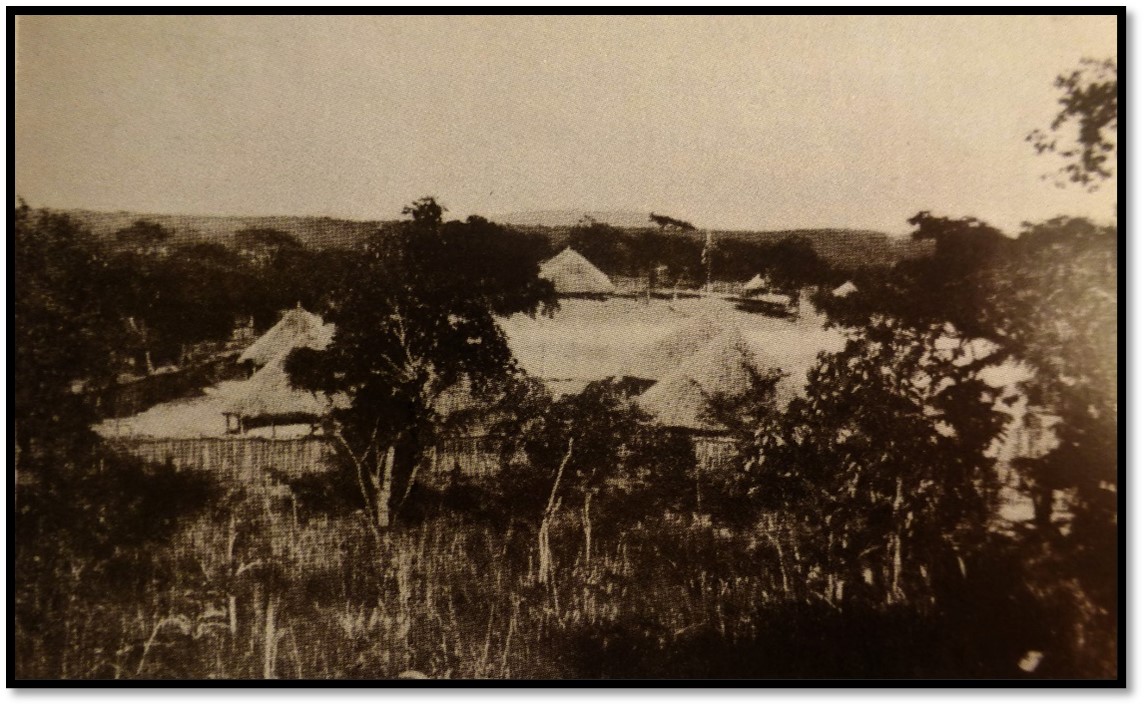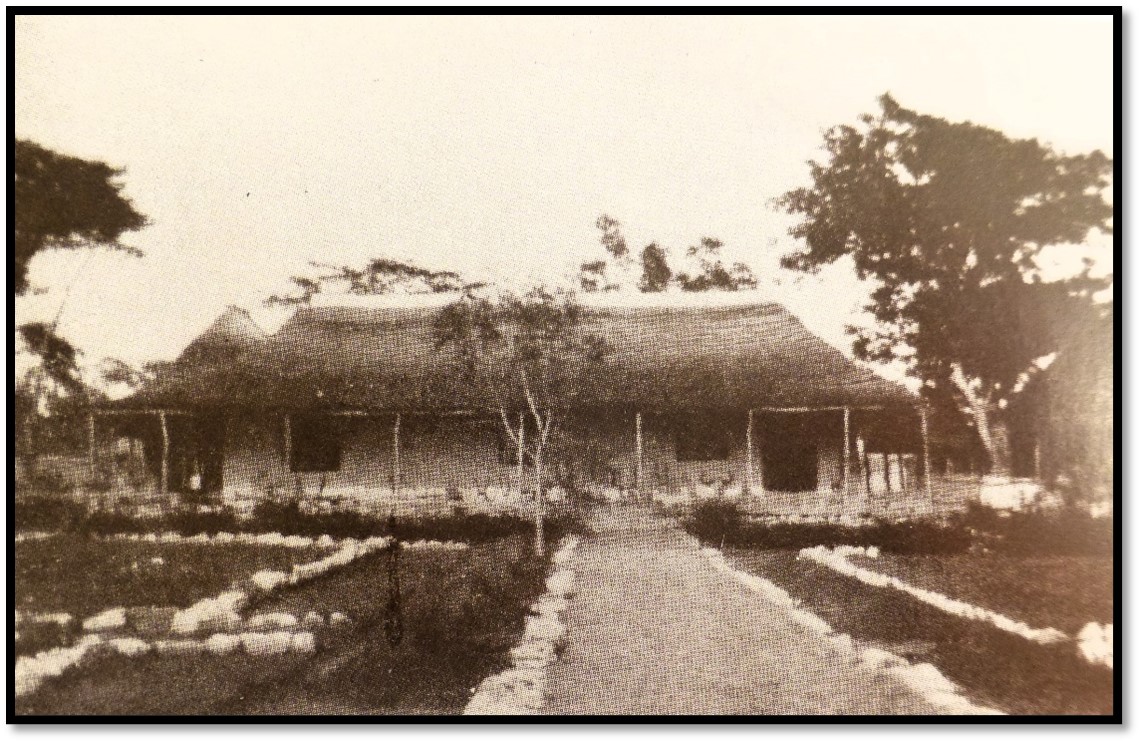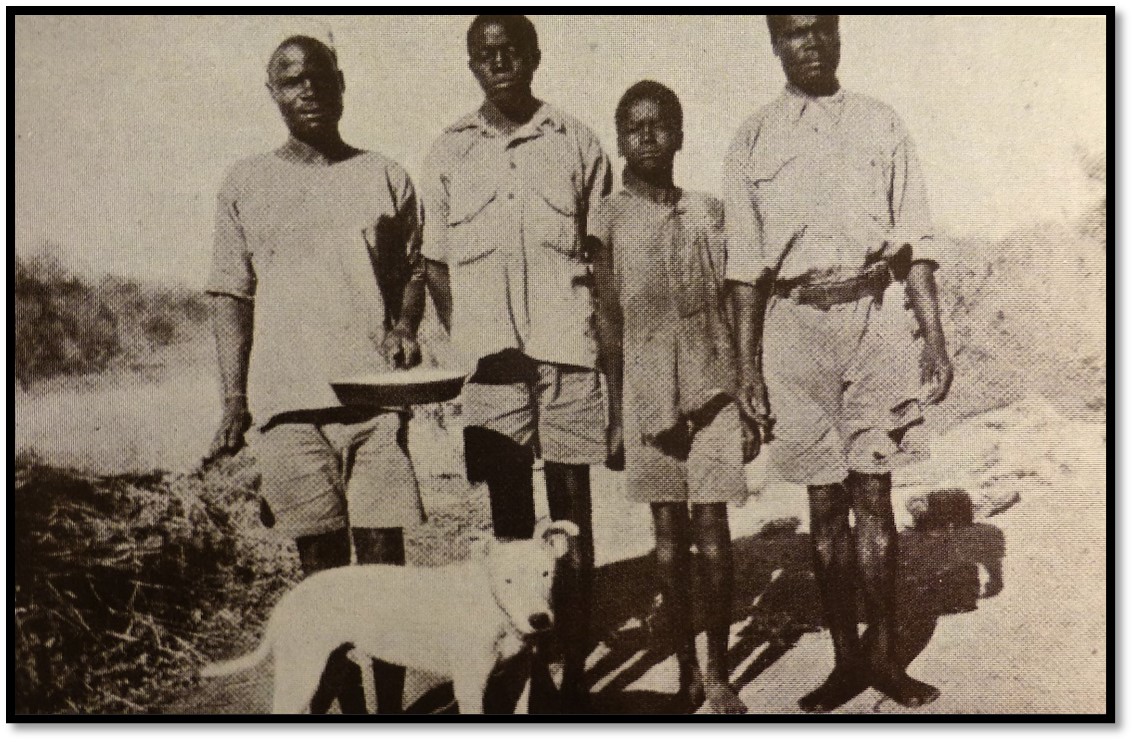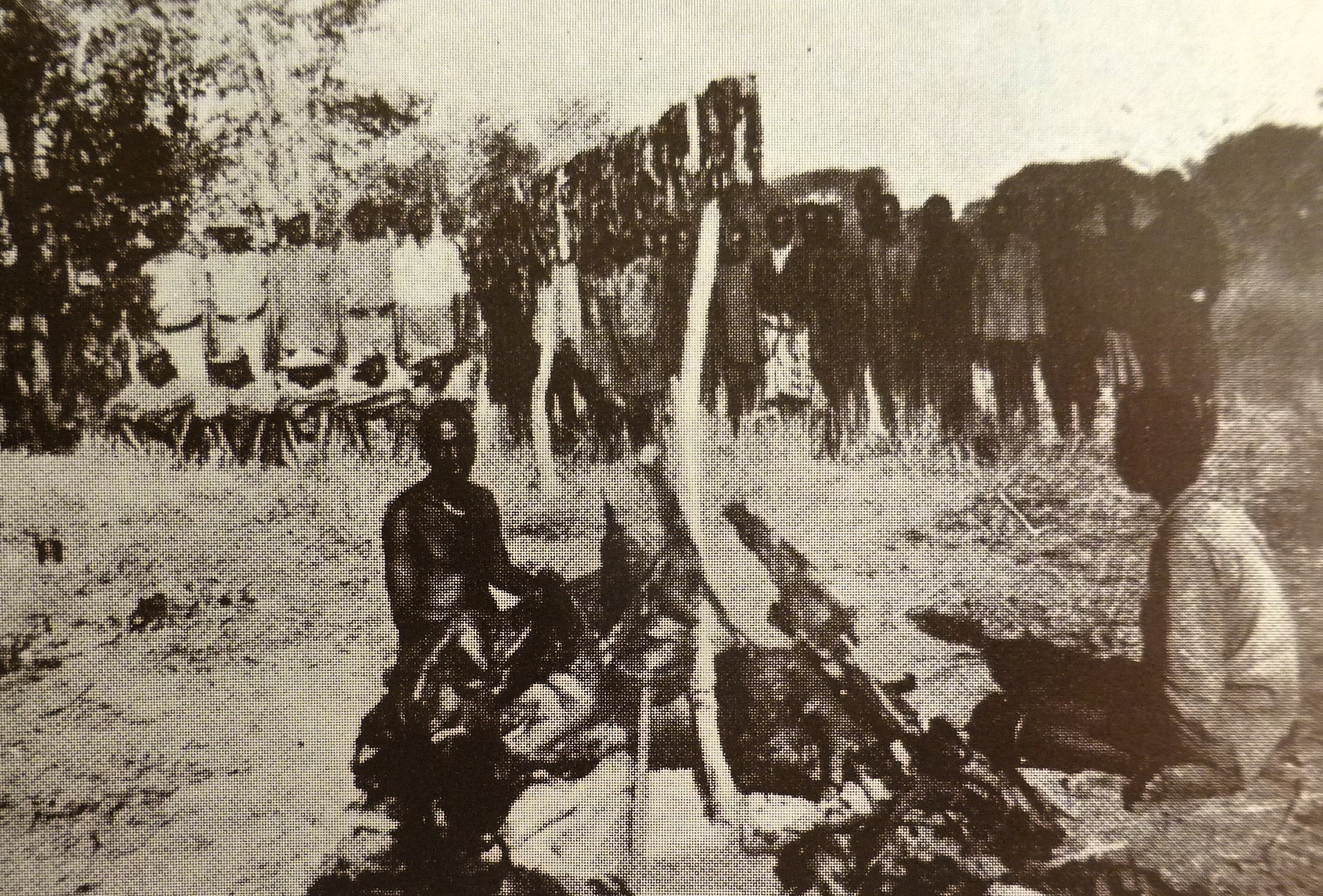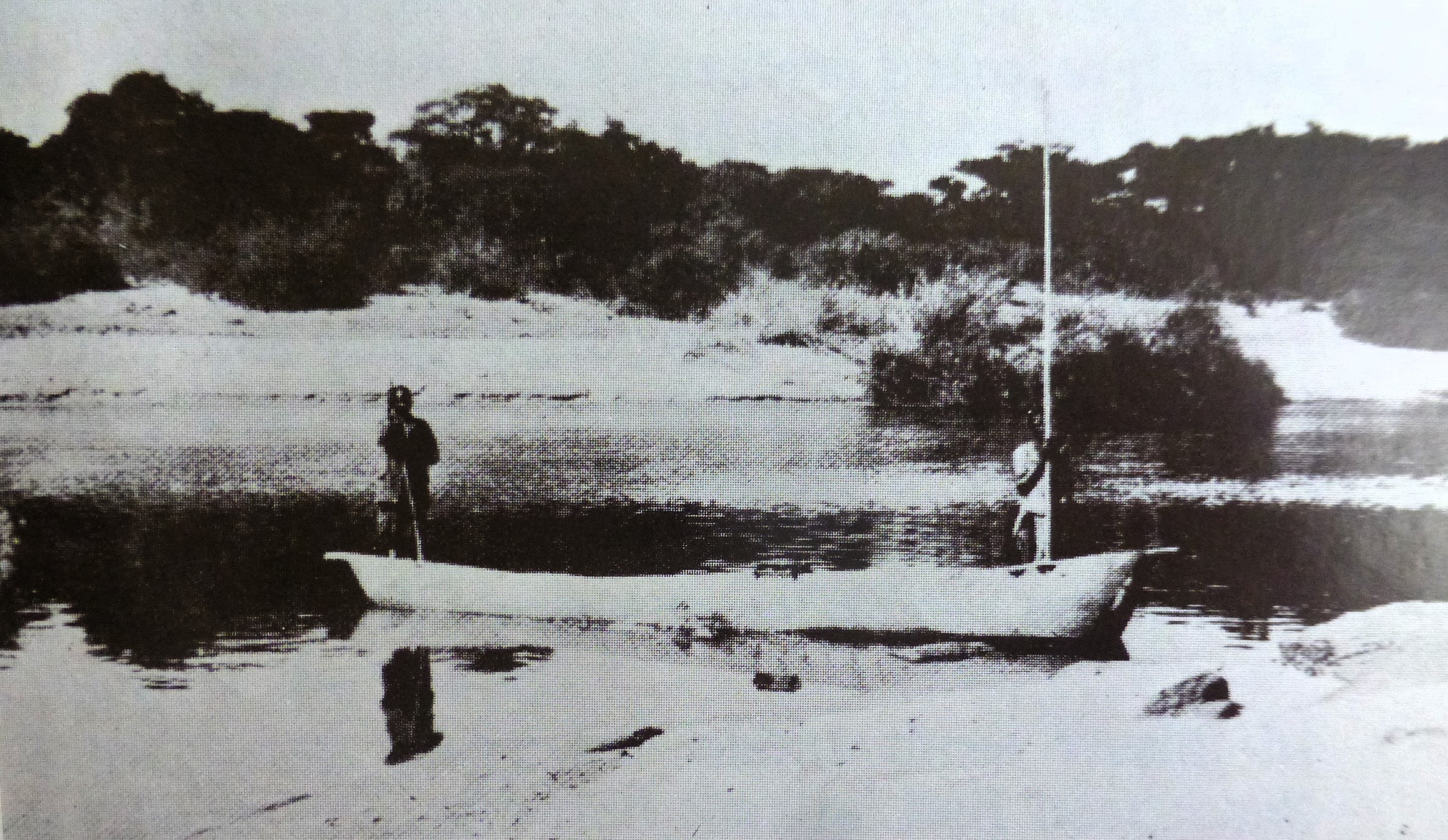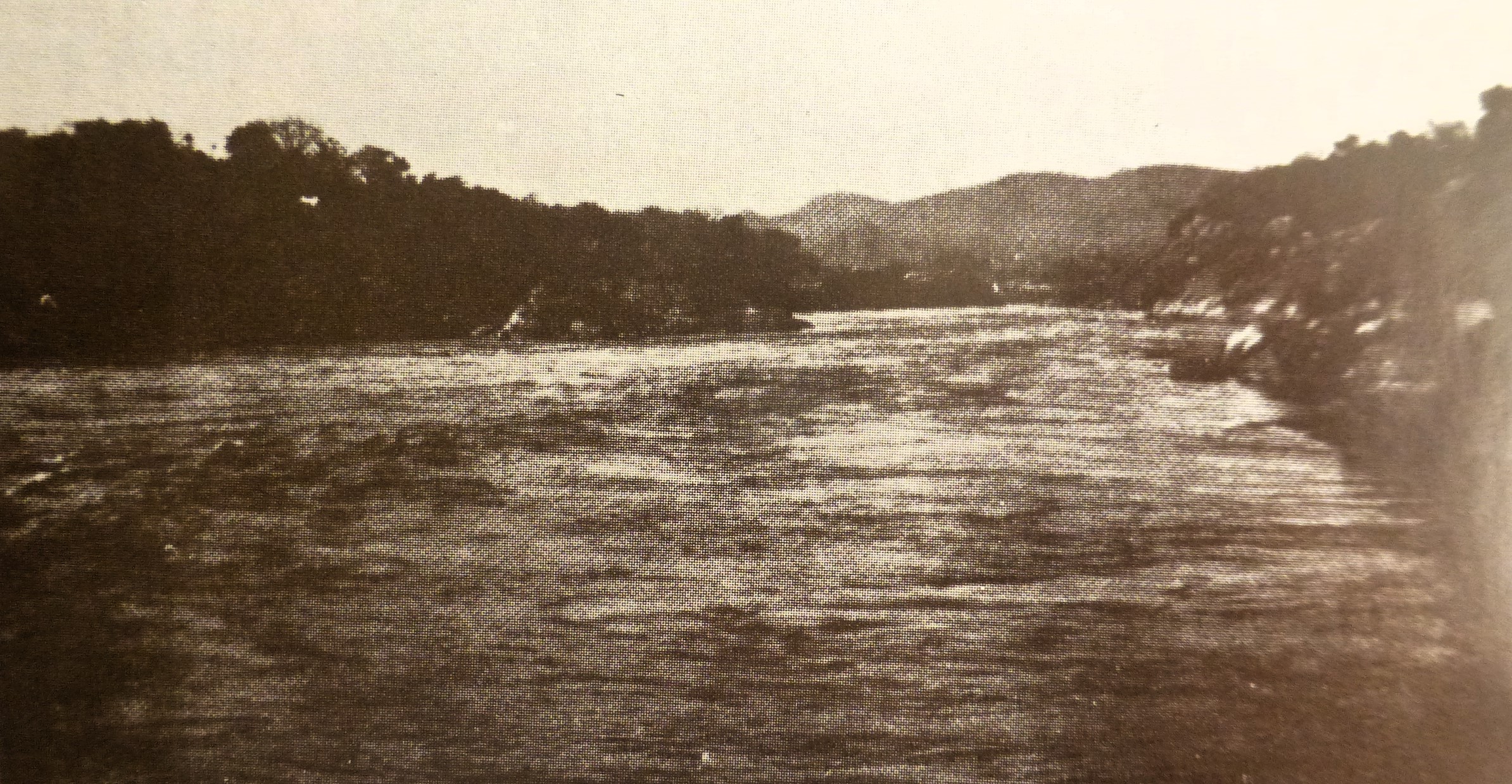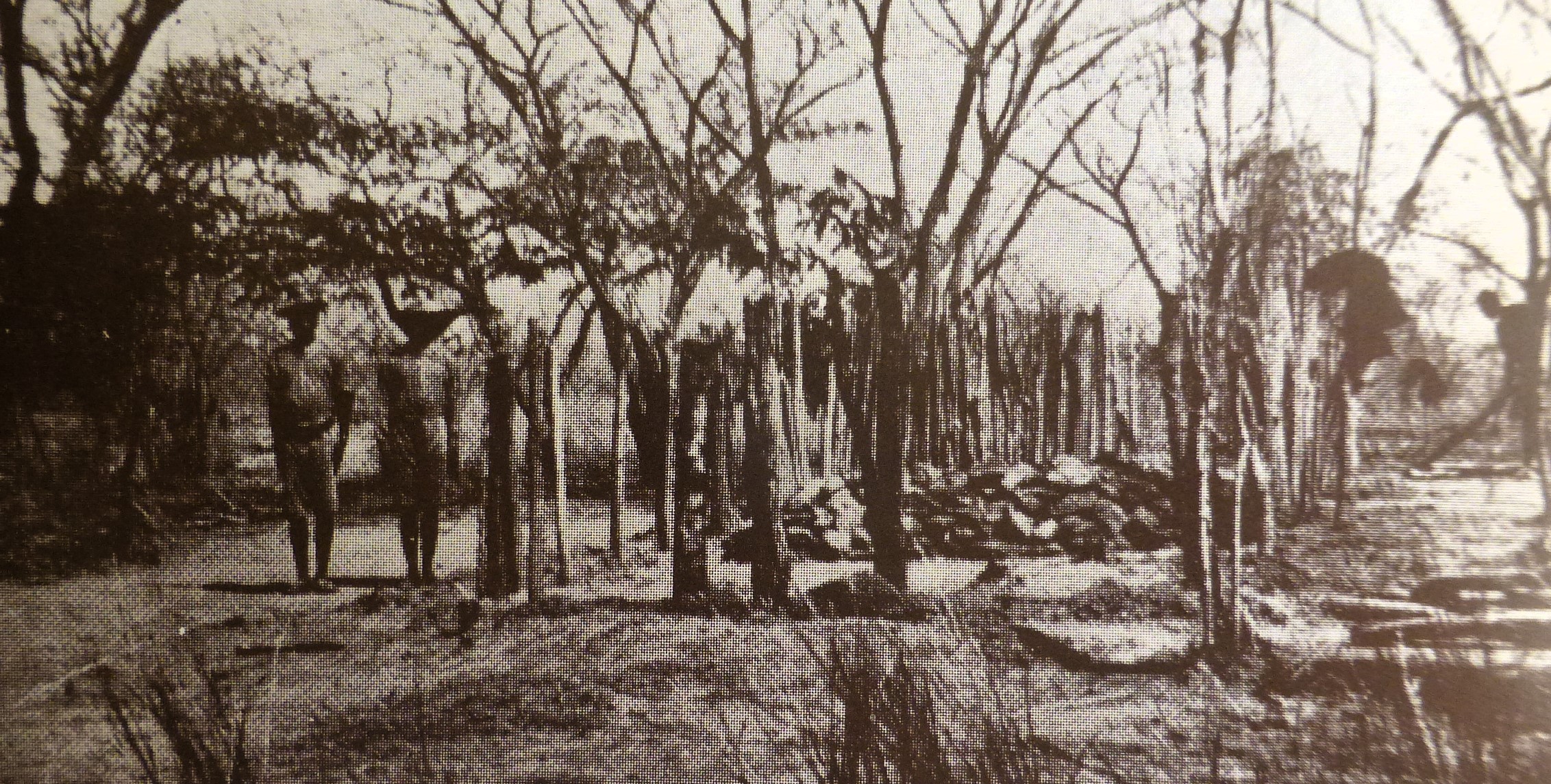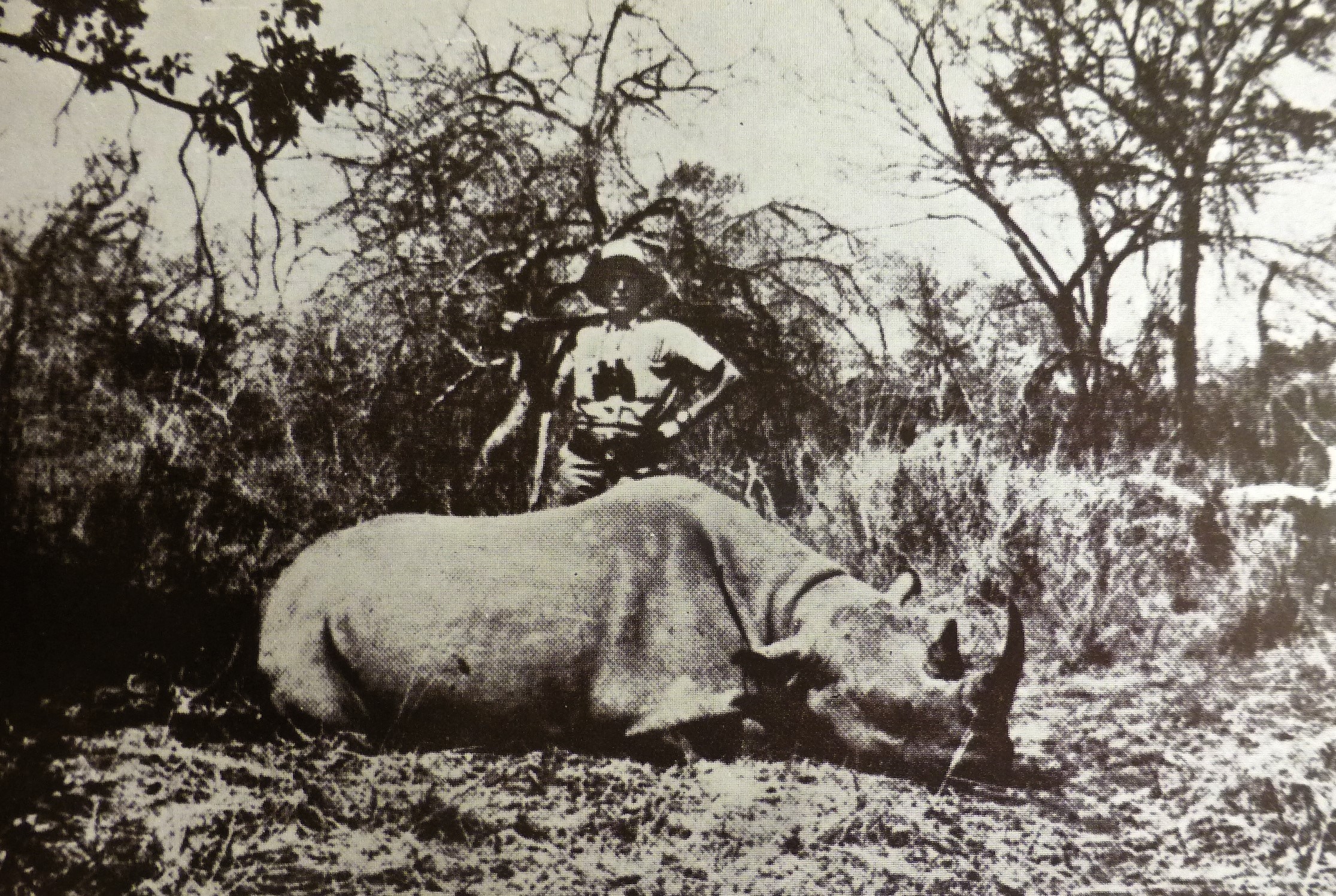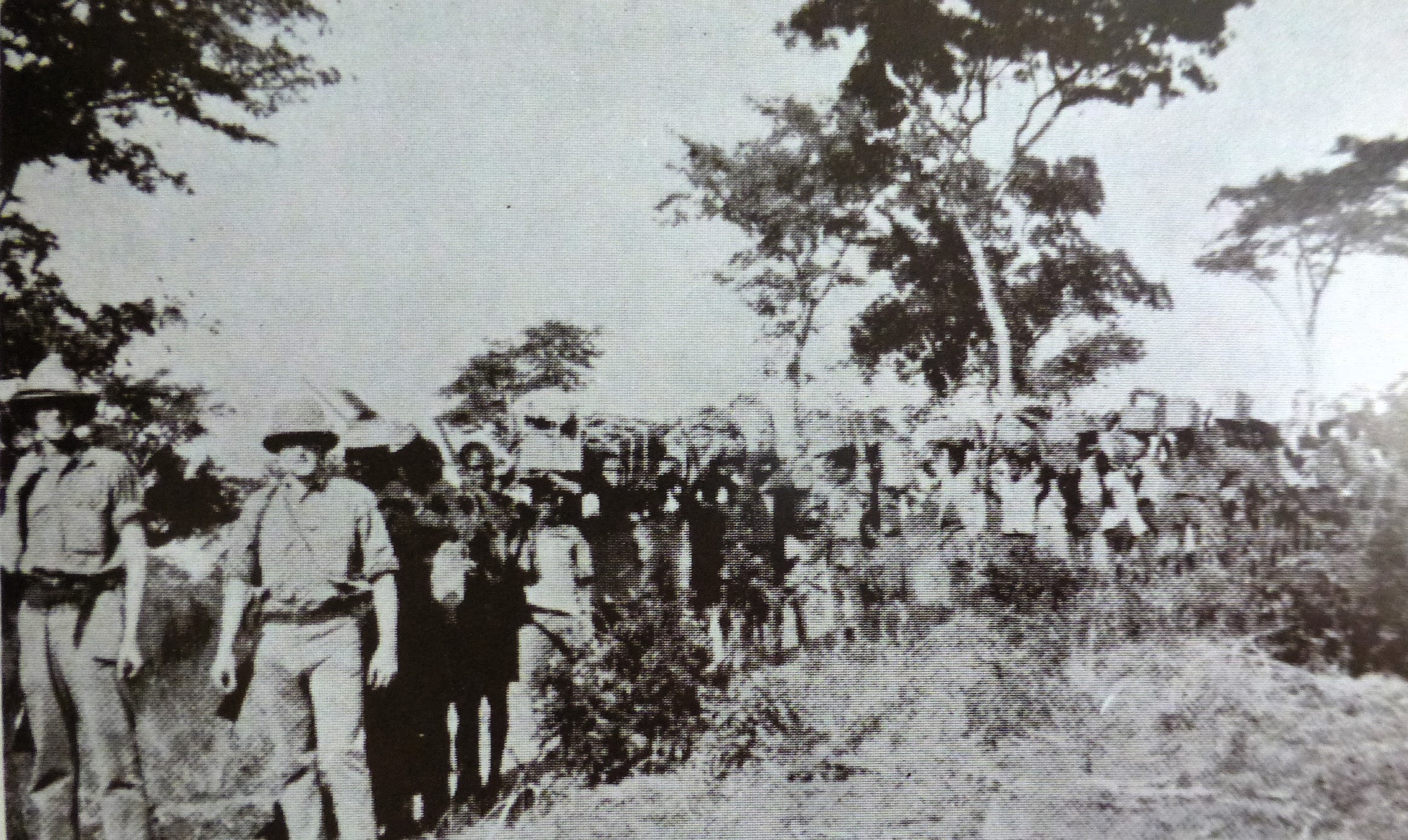Home >
Matabeleland North >
A Native Commissioner’s life in the Sebungwe District prior to World War I
A Native Commissioner’s life in the Sebungwe District prior to World War I
Introduction
In his autobiography, The Log of a Native Commissioner, Herbert Nassau Hemans (1871 – 1935) describes how in 1910 it required a walk of well over 100 miles (160 kms) in the Sebungwe district through a vast semi-arid region with his belongings loaded in a scotch-cart drawn by six oxen during October, the hottest month of the year, to get to his new posting at Old Gokwe. His companions were the driver and leader (voorlooper) of the scotch-cart and an armed native messenger who led Hemans’ steed, a white mule.
His well-written account is the product of a good education at Dulwich College and then Balliol College, Oxford. In the introduction he writes that all of his diaries, except one, were lost or destroyed, so that he only had his photos and game trophies to guide him, besides his memory.
H.M.G. Jackson, the late Chief Native Commissioner for Southern Rhodesia reminds us that tsetse-fly were so prevalent in the Sebungwe District that there was almost no domestic stock and the small communities were always clustered around a reliable water supply. For this reason few Native Commissioners wanted to serve in the Sebungwe district, but for Hemans it was the lure of dangerous big game including elephant, rhino, buffalo and lion that proved irresistible.
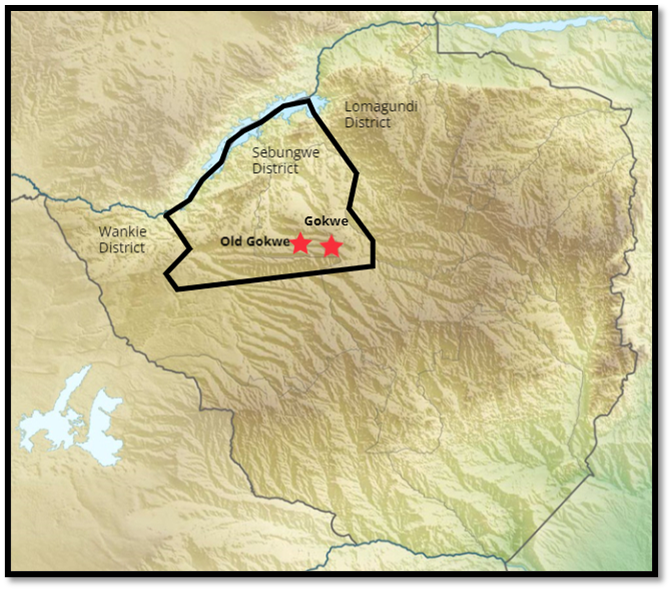
Map showing the Old Sebungwe District of Southern Rhodesia
In fact the book is really a round-up of his hunting activities during his period in the Sebungwe; his duties as a Native Commissioner are mentioned almost as an afterthought, although I have no doubt he was fair-minded and conscientious in all his dealings with the communities. There is some description of the BaTonga people, but very little on the Bashankwe people and very little on what his day-to-day activities actually comprised, which is a pity. Perhaps the loss of his diaries, already mentioned, was responsible for this.
Travelling to Old Gokwe circa 1910
Getting to Old Gokwe necessitated trekking soon after dawn to reach water before the sun became too hot, then resting until 3pm and trekking on until the sun began to set and they camped for the night. He writes the journey went without incident except for the mopani flies that made life so uncomfortable he was forced to sit in the smoke of a fire; the remedy proving almost as bad.[1] Antelope were shot for the pot and the occasional thunderstorm before the main rains made things uncomfortably humid.
Amazingly 68 miles (110 kms) into their journey he bumped into an ex British South Africa Police colleague named Meares who was living with his brother in a valley through which flowed the Sikombela stream. They had established a flourishing orchard and vegetable garden and were growing a grain crop. He writes he revelled in the eggs and bacon, bread and butter and fresh milk. Too soon it was time to move on to relieve his predecessor who was waiting to go on leave. In 1898 he had been in the area as escort to a surveying party assessing a possible rail route crossing the Zambesi river at Kariba gorge.
In 1925 he says a Mrs Crutchley lived with her husband and two little girls on the Ngondoma river within 8 miles (13 kms) of Meares. For years she lived a totally isolated life 64 miles (103 kms) from the nearest place that was only reachable by ox-wagon on wagon tracks that required a journey of five or six days.
After a rough journey that included climbing a steep escarpment that necessitated ‘all hands to the wheels’ to help the lumbering oxen, then hard going through a lengthy stretch of sandy gusu and a long vlei of black soil that was cracked in every direction, they reached Hemans’ new posting. The books and cash were hurriedly checked and Hemans was suddenly in charge supported by two white clerks, Zunckel and Dives. The native messengers, mostly Matabele, a fine looking lot of men, were lined up and inspected with a welcome from the sergeant and a short greeting from their new boss.
During the same afternoon a ‘Tin Lizzy’[2] rolled up driven by an old friend, Hugh Wiliams, with H.M.G. Jackson, the Superintendent of Natives,[3] two native messengers and the carcass of a dead lioness stowed away in the back that Jackson had shot about 20 miles from Gokwe. Hemans writes, “After tea, the visitors had a steaming hot bath and change after which we all four gathered in the mess-hut for sundowners.”[4] He goes on to say they all sat down to dinner in shirt sleeves, it being a breathless October day…this being described as an unconventionality!
The Sebungwe District
Hemans writes that the district had a very sparse population because of its low rainfall, land suitable for pasture and arable farming was very limited, a shortage of permanent water supply and distance from the railway and the prevalence of tsetse-fly.
At the time the only agricultural export was tobacco which was carried by hand or on donkeys to the nearest markets 150 miles away; its’ production is described later in this article.
Over the course of six years Hemans patrolled almost every part of the district, except the ‘fly’ belts where there were no humans and went to areas no white had ever been. He says the patrols were no picnic. They start early in the winter; the morning might be frosty, but soon they are soaked from the wet grass. Later when the sun is up it is blazing hot. They are forced to follow the paths that might go through miles of sandy forest (gusu) or along dry riverbeds, or an interminable series of dongas, or stony hills. Often the next known water source dictates when the day’s march begins, or halts.
During the day winged pests can make life miserable. It might be the tsetse-fly with its sharp sting, or the mopane fly in search of moisture getting into a victim’s nose, eyes or mouth, or the tiny sand-fly whose bite left itching bumps that are hard not to scratch! Along the edges of a vlei or pan, clouds of mosquitoes make themselves unwelcome and even on the Zambesi river hippo-fly take minute pieces of skin with each bite.
To compensate he says were the morning halts with a good breakfast, then shave and hot bath and in the evening a sundowner followed by a cooked dinner and a quiet smoke by the fire before settling into bed.
Old Gokwe Native Commissioner’s station
He describes the outstation as covering about three acres and surrounded by a tall stockade of poles with openings that were closed at night to keep out lions and hyenas. The offices and living quarters were all pole and dhaka with thatched roofs; each about twenty feet in diameter with a three foot gap between wall and roof for ventilation. It was situated on the crest of a knoll with steep slopes on three sides and views across to the hills in the north. A mile from camp was a flourishing vegetable garden, also sheep, goats and fowls.
Sometime after Hemans arrival a British South Africa Police post was established at the station with a white N.C.O. and two troopers, and eight native police, but at the same time his own native establishment was reduced by the same number. The native police executed warrants of arrest and served summonses and subpoenas. The policemen had their own huts within the stockade and were able to spend some social time together. At any time one of the whites was usually out on patrol.
Old Gokwe in Herbert Heman’s time
New Gokwe with its whitewashed stones!
The role of a Native Commissioner
The District included twenty-three Chiefs including Chief Sileya, the Paramount Chief of the Bashankwe, who formed the largest population group. Along the Zambesi river were settled many Batonka and in the north-east Makorekore, who spoke the same language as the Bashankwe, but were not related.
A Native Commissioner’s (NC) duties included collecting taxes, settling many and varied civil disputes, hearing and investigating complaints, registering births, deaths and marriages and divorces as well as investigating accidents. Adult males were taxed annually one pound and a further ten shillings for each additional wife.
Much of the administration work was carried out in the autumn / winter months from March to October when it was cooler and drier with each Chief being visited in turn. This saved the natives a long round trip to pay tax and enabled the Native Commissioner to get to know each of the Districts, the natives, their surroundings, crops and any difficulties they were experiencing.
In the absence of a hospital or clinic, NC’s were often called upon to treat simple ailments and minor injuries. The station carried large bottles of medicines to treat fever, diarrhoea, coughs and colds, dressings for wounds and burns, leg and arm splints, disinfectants and bandages. They were given no medical training; experience was gained on the job with many children being treated for burns.
In addition they served as an assistant Magistrate and dealt with all criminal cases that were not serious enough for the High Court. A local gaol served for those sentenced for up to thirty days, longer sentenced prisoners were sent under police escort to Gokwe to serve out their sentence.
Hemans writes, “the work in the more remote districts is, as elsewhere, ostensibly the collection of revenue, but in reality, we are the fathers of our people. Not only must the Native Commissioner possess a thorough knowledge of the native language, the laws and customs of his charges, but he has to administer them in such a way as to make them happy and contented…A native dissatisfied with the decision of his Native Commissioner always has the right of appeal to the Court of the Chief Native Commissioner, but such appeals are few and far between.
Personality, and a strong one at that, is an essential in a successful Native Commissioner…I have always maintained, and still do, that it is due to the personality of the Native Commissioner that they pay as they do and not to the fact that a few European and Native Police are stationed in the district. Not by fear can you rule them, but rather by the way your personality appeals to them. This is more than born out when I say that a population of about one million souls is administered by some thirty Native Commissioners.

Postcard of the Native Commissioner and staff, Native Police and Messengers at Plumtree about 1904
They are wonderfully law-abiding and the percentage of serious crimes among them is but a small one. Hospitality is one of their strong points and I always found them civil and respectful in their attitude towards the European. I bought the name Matandidwala (lover of rocks) Later on I received the name of Mlomonunye in addition, and of which I was very proud, as by it the natives implied that my talk was straight.”[5]
Postal Service
There were post runners between Gokwe and the nearest Post Office at Que Que. One arrived and another departed once a week and took three days for the journey. Each runner was accompanied by a carrier and was armed with a rifle against lions. At intervals were erected ingalane, sheltered platforms, where they could spend the night and sleep in safety.
Rhodesia, A Postal History lists a Sebungwe Post Office Agency opened in 1902 but closed in 1905.[6] I looked for a Sebungwe British South Africa Company postmark but found none listed so they must be rare.
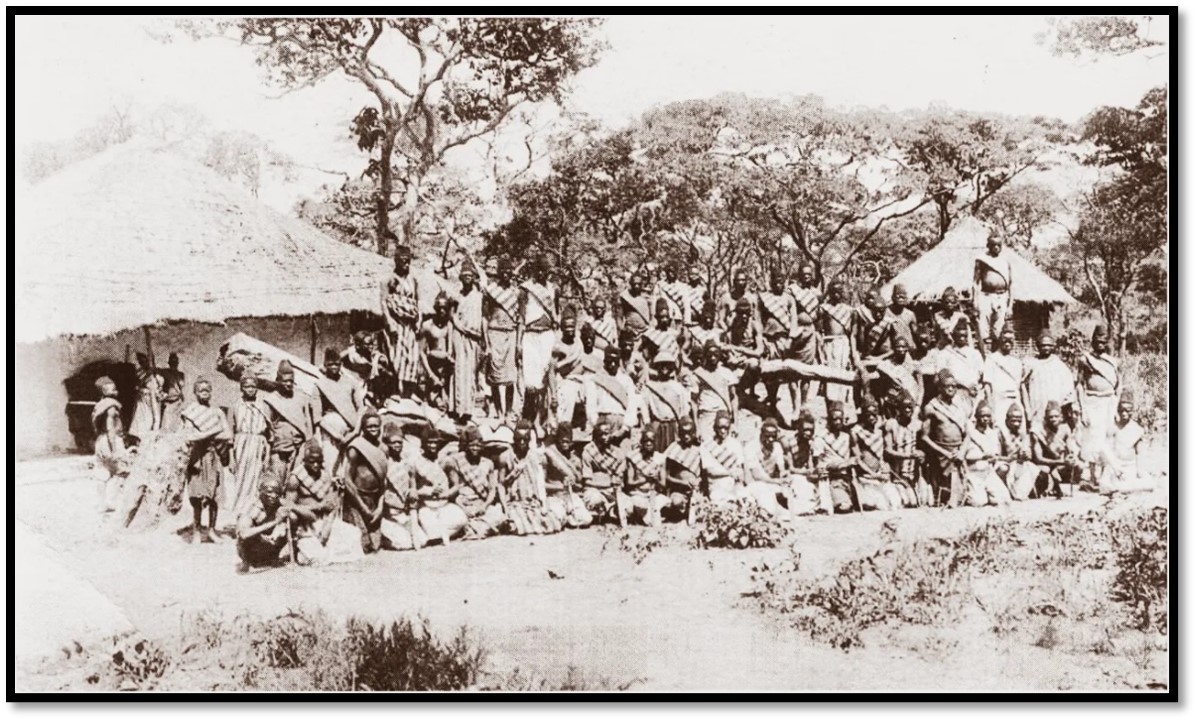
Photo from www.zambianhistory.com/postal-and-currency: Post runners of the North Western Rhodesia Postal Agency
gathered together pre-1907
The same website states the post runners’ uniform consisted of a long khaki smock with short sleeves, leather belt and striking red fez. The runner was expected to cover about 20 miles (32 kms) a day and carry up to 40 lbs of mail. Presumably uniform and conditions were much the same in Southern Rhodesia.
Life when it rained – his first Sebungwe patrol
His first patrol had to be cut short because of the prolonged rains that came down incessantly and turned small dry spruits into raging torrents “fully twenty feet wide and goodness knows how deep.”[7] As soon as he put his feet outside the tent he was calf-deep in mud “and after a time, the water started to come in under the tent walls.” It rained for a solid thirty-six hours and the patrol was marooned on a small rise where they had camped surrounded by a “veritable lake.” Once the rain stopped and the water drained they got underway again but, “It was terribly hard going as our way lay entirely through Mapani (sic) veld where the mud was as sticky and tenacious as thick mealie-meal porridge and considerably heavier.” This patrol was cut short and they returned back to base.
A further setback on this patrol was after stumbling in a stream so only his rifle was visible above water and he found to his dismay, “my cigarettes which reposed in my hip-pocket were a pulpy mass, my matches were sodden and my tobacco bag, carried in my belt, hopelessly wet.”
A long patrol to the Zambesi river
Preparations commenced in June after the long rainy season for a long patrol. Hemans’ ‘battery of firearms’ consisted of a double-barrel .450 Express, .333 Jeffrey, .303 Lee-Enfield, .22 rifle, Greener 12-bore double-barrel shotgun and a .32 automatic pistol[8] with plenty of ammunition. Camp equipment included two E.P. tents and a bell tent – standard government issue.
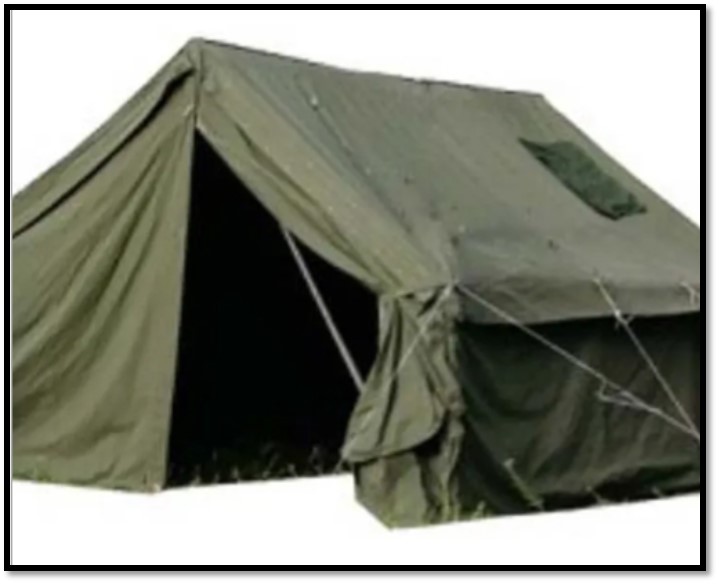
A 14 x 14 foot EP Tent with aluminium poles
Foodstuffs were sufficient for three months and were tied up into fifty carrier loads not exceeding 63 lbs; seven messengers were detailed for the patrol, plus Towel the cook, a table and a tent boy, pony and two dogs and all the office-books and stationery gathered for the tax collection. A weekly runner would keep in touch with base. Two of the messengers acted as gun-bearers, the remainder as escorts.
Hemans personal servants, Towel on the left
He doesn’t state the starting point, but I think it must have been Old Gokwe. The patrol left the first week of July, the first day finishing at 4pm to allow for camping procedures to be bedded down. At the camp site carriers were told where to lay down loads, some detailed to clear grass and bush, others fetched firewood and water. The messengers erected the tents, something they were used to and the cooking fires were lit. Hemans meanwhile sat in his folding rorkhee (sic) chair in the shade of a tree and enjoyed a cup of tea from his thermos!

An English oak military Roorkhee campaign chair
Once firewood and water was collected, the carriers were directed to their sleeping places, four or five to each fire placed around the camp. The messengers and Hemans servants each had their own EP tent and fire and dinner was served punctually at 7pm. “After dinner I sat by the fire while I drank my coffee and smoked at ease, my dogs at my feet, then wrote up my diary and later watched dark forms flitting in front of the many fires while I listened to the babble of talk from all sides… At 9pm I blew two long blasts from my whistle which was a signal for quiet and the Sergeant bellowed out, ‘Tulani umsindo’ (Stop your noise)”[9]
The days started at 5am; by 5:30 Hemans was sitting by the fire with a steaming hot coffee and dry rusk and the camp was being packed up around him. When Hemans blew his whistle the carriers squatted by their loads and once he was satisfied all was in order, set off with his gun-bearers and dogs along the path. The Sergeant gave the word ‘Endhleleni’ (on the way) and the carriers shouldered their loads and followed on.
Daily routine on patrol
Even in the Zambesi Valley the mornings before sunrise were cold, everything white with hoar-frost. Soon everyone was dripping wet from the shoulders down from the tall grasses that grew along the path. By 9:30 am they would have covered 10 miles (16 kms) and would stop in a convenient place to wait out the hottest times of the day. First would be breakfast, “a steaming hot bath improved matters greatly and I felt more my own man again.”[10]
At 2:30pm “I sounded my whistle preliminary to making a start, when all was again bustle and noise.” Journeying through the hills took three days before they reached a beautiful green vlei, the tall winter grass had been burned off by wandering bushmen [San hunter-gatherers] and native hunters and the new grass emerging was vivid green. There had been few signs of game previously, but now there was eland spoor and lively discussions began amongst the carriers as to future possibilities of nyama (meat)
Nearby was old Wata’s kraal; a pensioned off messenger after many years’ service who greeted them with, “the remains of a felt uniform-hat rammed well down on his head, a ragged grey-back shirt and what was left of a pair of khaki shorts which were as Joseph’s coat as regards the multi-coloured patches whose area covered almost more than the khaki.”
He did however supply a guide and Hemans was anxious to lay in a good supply of meat for the carriers. “I considered it was up to me to make their unenviable job as pleasant as possible and it was indeed poor fun to hump a heavy load some 20 miles daily for the sum of 6d., in addition to all the other odds and ends of jobs they were called upon to do.”
Distances are a bit vague in Africa
The guide said water was a long way off, so they set off at 1:30pm and to his surprise it was just 4pm when the guide pointed head and said “Nank’ amanzi” (there’s the water) and to his amazement two fat eland cows were moving 300 yards across their front. A shot from the .333 over their backs and they changed direction towards the party. The carriers had come to a halt, now silent and crouched down and both eland dropped dead. “And then what a babel of shouts, cheers and laughs!” Here was meat for a good gorge and plenty to dry out for future consumption. “When dusk fell with the fires burning brightly, strips of meat were to be seen hanging from every tree and bush while livers and entrails were being grilled over the hot embers.” Hemans kept a couple of marrowbones for himself writing “there are few greater or tastier delicacies than eland marrow on toast.”
Meat drying in the sun
Next day the march continued along the north bank of the Kana river with halts and camps arranged where Hemans pleased as there was now plenty of water until the Kana’s confluence with the Shangani river. Now there was plenty of game, an important consideration as the more meat the carriers had the less of the loads of maize did they consume as it would be needed in the future. Hemans writes, “it has never been my practise to shoot for the sake of shooting and, on this trip, where evidently every opportunity was to occur to shoot indiscriminately if one were of a bloodthirsty nature or wanted to make money out of skins and biltong, I confined myself strictly to killing only when I saw that the meat supply was running short, or when I noticed to particularly fine head or animal I had not yet in my collection of game trophies.”[11]
He says one afternoon he saw one of the finest sights for a lover of animal life to come across Heard. A herd of at least one hundred eland below and beyond on the gently sloping bank on the other side of the Kana river. Some of the bulls must have weighed 1,200 – 1,500 lbs and carried massive spiral horns. “We had plenty of meat so did not shoot and we were able to watch them strolling up into the trees to disappear in the forest. It was a grand sight and one I shall never forget.”
They continued down the Kana, “Sable, roan, reedbuck, tsessebe and eland fell to my rifle.” Then one morning he spotted a pair of lions. “I fired at the leading lion, which was a male and a big one at that but in my excitement at seeing the first of these big beasts in my new District I was too quick with my shot and fired too high. He made off at a gallop and disappeared into the bush but the lioness followed more slowly, stopping occasionally to look in my direction…She was then not more than 70 to 80 yards from me and offered a good mark. Dropping to one knee to ensure a steady shot and holding my breath, I fired but, to my utter disgust, apparently without effect, and off she went too.” Although frankly I was in a blue funk…They entered very gingerly into the long grass scanning intently every bush and every tuft of grass…until we had gone some 50 yards…”My feelings can be imagined when I almost trod on the lioness, lying facing me, but stone-dead…I gave a huge sigh of relief and then let out a yell which brought my boys up at the double. They threw up their hats and did a war dance around the victim shouting ‘Hip, hip, hoolay’ at the tops of their voices.”[12]
They leave the Kana for the Shangani river
At the Kana’s confluence with the Shangani they crossed to the south bank to reach the footpath leading to the Zambesi river. Next day they reach Sibazenungu’s kraal or ’Porcupine Quills.’ The headman himself wore and old blue Portuguese military overcoat and a red fez. Hemans remarks how much more relaxed and ready to talk the headman was in his own surroundings than when they came to his office, “discussing with you a hundred and one little matters that would never crop up in the office.” Hemans writes on common ground you are regarded as a friend and protector and not simply as a collector of revenue and a punisher of offenders.
He was told the villagers were soon moving because neither the people nor the stock were safe from the predation of lions. Quills told him, “They are now so bold that we dare not leave the kraal after 4pm in the afternoon nor until the sun is well up in the morning…Until we barricaded our huts and covered them with thorns, as we did our goat and sheep pens, they would climb up and tried to reach us through the thatch, pulling away the grass for that purpose.”[13]
That night he says, “Talk about a pandemonium! The leopard and hyenas did not keep it up for long, but the lions were still roaring when I woke next morning before dawn.” They tracked the lions but could not catch up with them but shot the biggest waterbuck he had ever seen…the horns measuring 33¾ inches (86 cm) along the front curve. Quills did move his kraal.
They had travelled as far west as they would go and now marched north.
They march towards Pashu’s kraal
After three days march through barren stoney hills they reached the first kraal where the collection of tax began; a messenger had been sent ahead to warn the villagers to be ready. Close by was a comfortable camp with pole and dhaka huts surrounded by a tall stockade of stout poles built for visiting Native Department staff. Tax collection took place next day, with individuals being given tokens to signify they had paid.
Hut tax tokens 1903 – 1931
The Native Commissioner would arrive at a village with his tax registers, enter new names and, in discussions with the Chief, decide claims for exemption put forward by those who had reached old age, or who had become infirm. Then the cash was collected and stored in bags which were sealed and packed in metal ammunition boxes.
The hut tax system was regulated under the Native Tax Ordinance of 1904. Headmen were responsible for collecting tax in their kraal and passing it on to the tax collector who gave a written receipt for the total. In addition, they were issued brass tokens for each person who paid tax that were passed on to the individuals concerned. Each token was stamped for the year in which it was valid and a letter indicated the District it was issued for with their size and shape varying from year to year. The larger token was issued to men and the smaller ones to women.
For administration purposes the country was split into two, Mashonaland and Matabeleland and this was reflected on some of the tokens. In Mashonaland for example, A referred to the Charter District. In Matabeleland A referred to Bubi. The 1904 regulations were replaced in 1917 by a new set with brass tokens continuing to be issued. In 1917 the regulations changed again with tokens only being issued upon request. The kraal head however continued to get a written receipt for the total tax handed over. After 1931 no tokens for hut tax were issued.[14]
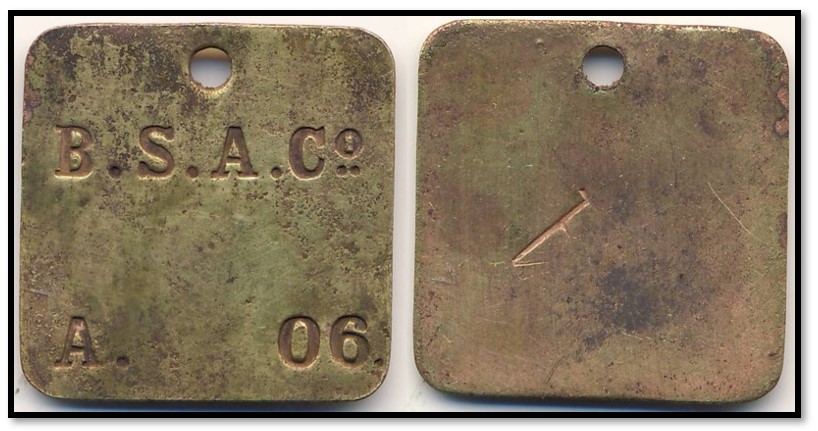
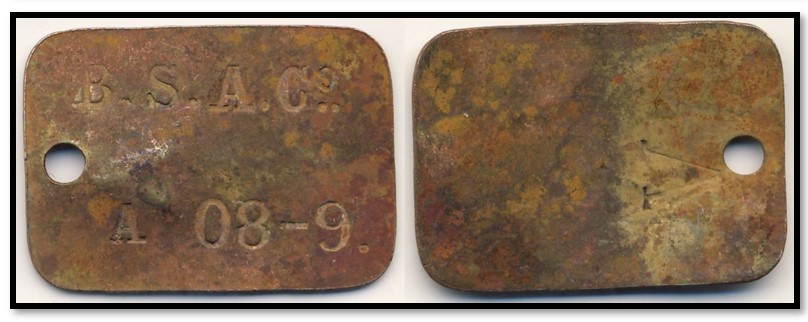
Photos World of Coins: hut tax tokens for 1906 and 1908-9
Gifts were repaid and all purchases paid for at market rates
Initially Chief Pashu presented himself to offer greetings and a number of "gifts" such as sheep, fowls, fresh eggs, milk and grain. Before departure, after the tax collection was complete, the native Commissioner himself would be expected to make gifts. Hemans "gifts" were made in silver coins carried for the purpose and were to the value of the provisions provided by the villagers earlier. This fiction of "gifts" was always firmly but politely applied. Any grain purchased, or eggs, milk, green mealies, sometimes native beer for the carriers was paid for in cash at market rates.
The journey continues to Tshabi’s kraal
The next stage took them to Chief Tshabi’s where they found another good rest camp near the Mlibizi river. The Chief complained of a man-eating lioness and her two cubs that had killed a number of people. It was too far to detour to the Chief’s kraal so Hemans gave him Martini-Henry cartridges and some strychnine with careful instructions. Subsequently the lioness was shot by a trap gun at a kill and the cubs to poison at another kill. The tax collection was soon done and they moved on
Kaviri Hot springs
Hemans doesn’t name the hot springs but clearly they are those that were at Kaviri[15] saying, “We reached the valley of boiling springs where the so-called path took us through eddying steam and mist tinged all shades of red and pink, and so dense that it was only with difficulty we could make our way, jumping from tussock to tussock of coarse grass to avoid the boiling water which ran from numerous streams springing from the low hills on our right to join the Mlibizi on our left.”
He says the river water was decidedly chemical to taste and tepid, the ground covered with a thick white incrustation but that the Mlibizi river had good quantities of fish, otters and crocodiles and he saw more game including two big herds of kudu and small buck within the surrounding five miles than the whole of the previous 35 mile (56 kms) march from Lubimbi.[16]
They reach the Zambesi river
A further march of 25 miles (40 kms) brought them to their first sight of the Zambesi river; here about a mile wide, “its banks fringed at the water’s edge with green reeds which swayed and curtsied to the flowing water, while over and above them great trees cast their ample shade. On a rocky islet towards the centre of the river basked a herd of hippo, while on a strip of sand nearer to where we stood, ducks, geese, a heron and marabou stork sunned themselves, sandpipers tripping daintily up and down in search of food. Down to the right on another sandspit lay a couple of crocodiles, one with wide open jaws, exposing rows of cruel teeth.”[17]
There was still a couple of days’ march before reaching Chief Binga’s village where there was a 20 foot (6 metres) steel boat to take the patrol the next 200 miles (320 kms) down the river. Tax was collected at Simariampongo and Sansali; the people along the river are Batonka and fish from their dugouts that are cut from a single tree trunk and propelled by poles in shallow water and by paddles in deep water.
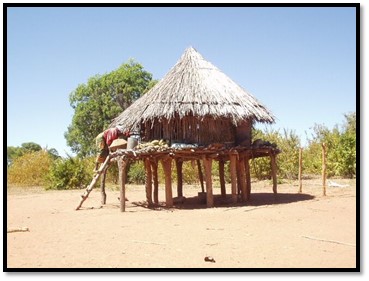
Traditional BaTonga hut that keeps the people safe from crocodiles
Chief Binga organises a welcome
The Chief was keen to honour the new Native Commissioner and organised some dancing, some depicting battles and others lion hunts and accompanied by a band with musical instruments consisting of whistles made from impala horns and earthenware drums covered in tightly-stretched zebra skin.
After collecting tax they went onto Binga where they found the boat already launched on the slipway with four BaTonga oarsmen and a Native Commissioner’s rest camp overlooking the river. Before they left Hemans decided to cross the river and visit the Kanchindu Mission Station in Northern Rhodesia (now Zambia) where he had a warm welcome from Mr and Mrs Fell, Wesleyan Ministers and Mr Buckley, formerly a carpenter. He says the trip was worth it just for, “a cup of morning tea with delicious hot scones, most daintily served in pretty china in a cool, airy room by neat maids dressed in dark-blue frocks and snowy-white aprons and caps” before accompanying the missionaries around the mission station.[18] All the building materials had been transported from the nearest point of the railway at Kalomo, 90 miles (145 kms) away. There were school rooms, dormitories for boys and girls, a workshop, forge and dispensary.
Threatened by a man-eating lion
The Fell’s told him that at least 17 people were killed by a man-eating lion. One night they went to bed, leaving an Airedale dog chained outside to the veranda. They were suddenly awakened by a yelp followed by scratching at the mosquito-gauze frame of the window. Mr Fell got up and went to the window to find himself face to face with the lion. He brought up his ready-loaded rifle and fired a shot point-blank into the lion’s face. Next morning they went out to find the lion lying dead beneath the window with the Airedale also lying stretched out, killed by one blow from the lion’s paw.
Passage downriver by boat to Binga Hot Springs
Hemans arranged so he had in the boat a deckchair, camp-table, shovels, skoff-box, guns, camera and thermos, plus some cushions. His personal servant, Nkani, sat in the bow with his gun-boy, Johnny and there were four BaTonga crew. The remaining party followed by footpath along the riverbank. The next stop was just a few miles on as he wanted to view the geyser at the foot of the Zambesi escarpment and a few miles inland.
The geyser at Heman’s visit in 1910 came out as a fountain about 7 feet high (2.1 metres) the water being boiling hot and it fell into the basin beneath. The steam could easily be seen and the jet of water continued steadily and with unvarying volume with a strong smell of sulphur with the water in the rocky basin beneath quite blue.[19]
The Bulawayo Chronicle reported that these days the geyser hardly rises above the ground and local BaTonga people believe the ancestors have been offended by human activities. They have believed it was a sacred place for generations and rain-making ceremonies were conducted here. Zimparks believed that fencing off the site would protect it, but Chief Sinansengwe of Binga said the hot springs have lost cultural significance.[20]
A concert for the local BaTonga
Once dinner was finished Hemans lit three acetylene lamps to supplement the log fires as numerous villagers had gathered to listen to his portable gramophone and his musical records and he was keen to see how they reacted to them. He says no audience could have been more appreciative. “The roars and shrieks of laughter from men, women and children, some of them absolutely doubled up and rolling on the ground, were such that I, too, laughed ‘til the tears rolled down my face.”[21]
The journey continues
He had been joined by Theo Zunckel, one of his clerks, to help with the tax collection and they each travelled by boat on alternate days. When they left Sinekoma Hemans shot a hippo, but it proved impossible to pull the dead hippo from the shallows with a boat. After some time the carcass filled with gas and a team of carriers and messengers managed to roll it onto a sandspit where it was skinned and cut up.
At Siyaumpa,[22] two days further down the river, Hemans shot his first rhino. He had set out early in the morning, “when I did see it, I was so taken by surprise at its appearance that for a second or two I did not even raise my rifle to shoot. As he stood facing me not more than 20 yards off he presented the appearance of a bulky triangle, his horn forming the apex and his chest the base. The legs I could not see as they were hidden in the thick scrub. The sun was behind him and he loomed dark and forbidding, his head well up and looking straight at me. Recovering from my surprise, I quickly aimed at the base of the neck and gave him a shot from my .450, whereupon he wheeled round and galloped off, crashing through the bushes as he went. Following hard on his heels, we had not gone more than 50 yards (46 metres) when we found him lying dead in the direction he had been going.”[23]
At Siyaumpa’s a young girl who had been collecting water at the river was carried in having been attacked by a crocodile. She was in a terrible state and Hemans tended her wounds as best he could, but she only lived a few more days.
Tshete (Chete) Gorge
After Siyaumpa they reached the Chete Gorge which rose to the right of the river in steep cliffs of red sandstone where in earlier days there had been a Native Commissioners camp, now abandoned in 1910. Here after spotting two bushbuck the boat was allowed to drift until they were within shooting distance when two successive shots with the .333 brought them both down and when they had brought the boat to the bank, he managed to shoot the largest Kudu bull he had ever shot with horns 33 inches (84 cm) wide from tip to tip.
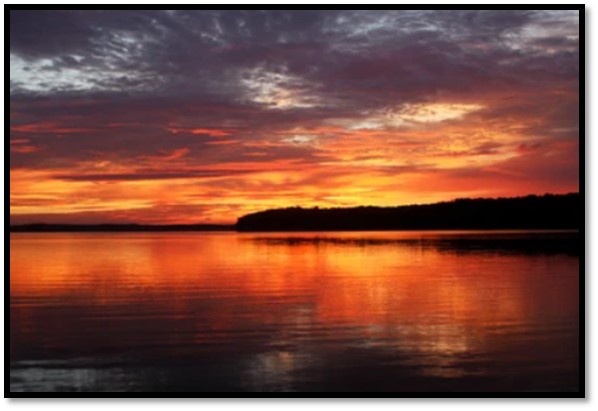
Chete Gorge at sunset on Lake Kariba
Chief Sinempande and an elephant hunt
Many of the carriers were now tired and he decided to pay them off and let them go home and recruit new carriers for the return journey to Old Gokwe. Here the Luzukulu[24] river runs into the Zambesi and Hemans was determined to walk to a pool a few miles up the Luzukulu and bag an elephant. They made an early start through very thick bush and reached the pool only to find the elephants had been and gone. The spoor was followed and near a pool of water two bull elephants were spotted and after creeping closer, Hemans let fly at the bigger one with both barrels of his .450 and saw dust fly where the bullets had struck.
He had only just reloaded the right barrel when he was charged by a third bull elephant that had not been spotted. He fired at its forehead and the animal simply collapsed. The fallen elephant was left and he went after the wounded one. They followed blood spoor for long time before it petered out and Hemans decided to go back to the second shot elephant. “It took us a long time to get back to where we had left our elephant and when we did get there what was my astonishment and dismay to find – nothing! I could not believe my eyes…That it was heavily hit was apparent as we could see where it had swayed and staggered from side to side as it went” but after some time it joined a small elephant herd and vanished![25]
An unsuccessful hippo hunt at Chief Sinagatenke’s kraal
The village may have moved by the time the SE-35-7 Binga map was published in 1973 and likely replaced by the Sinamwenda Research Station at the mouth of the Mwenda river. Here Hemans thought as they were short of meat he would try to shoot a hippo and borrowed a dugout and its crew from the Chief. Nothing was spotted, but the return journey required poling upriver against the current and proved a very tiring and lengthy process. “It was a case of hugging the bank and taking advantage of every piece of shallow water where the punt poles could be brought into play, the dugout being too heavy and too unwieldy to make possible the use of the paddles. Lower and lower went the sun until it finally set. There was I in that wretched, cranky, unstable dugout in pitch darkness but for the myriad twinkles from the bright stars overhead and the little fires burning on either bank from the lookouts where the natives sat watching their crops against the inroads of marauding hippo.”
A BaTonga dugout on the Zambesi river
Here Theo Zunckel left to take over the work of the office, and Dives, the other Gokwe clerk, who had marched direct from Old Gokwe, joined to finish the patrol with Hemans. Dives brought the startling news that Britain had declared war with Germany on 4 August 1914 and produced a copy of the Bulawayo Chronicle. Dives apologised for the stained condition of the newspaper – he had been so surprised when he saw the headlines that he had upset his cocktail![26]
Next stop the mouth of the Sengwa river
There was a permanent Native Commissioner’s camp here that is still marked on the 1973 map; the country in-between being so wild and infertile there was no native settlements. The huts were situated beneath enormous Musika (Tamarind trees)

Photo from https://nature-explored.com/tamarind-info.htm. Tamarind tree (Tamarindicus indica) Shona: Musika
There was plenty of lion, rhino and buffalo spoor, but none were spotted and three zebra and two waterbuck were shot for meat. The one shot at a waterbuck had passed through the animal and killed an almost full-grown calf at the same time.
Mola’s camp
This camp swarmed with mosquitoes from a swampy stream nearby and nets were an absolute necessity here. They moved on quickly and on 23 August reached the Bume river (present-day Ume) on the western edge of the present-day Matusadona National Park.
There were a chain of pools up the Ume where buffalo were reported to drink – it being the winter dry season. They left before sunrise and found a herd of buffaloes drinking at the pools. Hemans was setting the sight of the .450 on a large bull and “I was about to press the trigger when, without the slightest warning, the bull whipped round and made off at a gallop, the whole herd of about 50 making off at the same time without my being able to get in a shot… The buffalo, extremely keen of hearing, sight and scent, had evidently caught a whiff of tainted air or had, perhaps, heard a branch or twig break or a dry leaf crackle and without waiting had cleared off from possible danger.”[27]
They were followed up, “Time after time we came to places where they had been watching for us and had made off again, sometimes at a trot and sometimes at a gallop, before we could come up with them… Suddenly and without a word, my tracker pointed straight to his front and there I saw a black shape standing broadside on to me…I took careful aim at what I judged to be the shoulder of the animal and fired.”
Now the whole herd emerged and charged towards them – there was nowhere to run and no trees to climb and he told his two gunbearers, Nkani and Johnny, to fire straight into the herd when he gave the word. They all fired simultaneously and the herd came to a dead stop before coming on at a rush and separating on either side of the three hunters, “while we stood between them dazed by the thunder of flying hooves and blinded by the dust and gravel flung up by the mad stampede until the noise faded away into the distance…it was just sheer luck that we had not been trampled, horned and kneaded into pulp.”

Herd of Cape Buffalo (Syncerus caffer caffer)
“Our pursuit of the buffalo had landed us in a journey of 16 hours, during which we had rested for one hour only, all through the heat of a late August day in the Zambezi Valley and in as inhospitable a country as one could ever traverse.”
A two days journey brought them to Chief Sampakaluma and Heman’s first task was to lecture him on the disgraceful state of the path in his section along the river bank. Kraal heads were required to keep open good broad paths between villages as this made for easier travelling. The people here were Makorekore and quite different being generally taller and wearing long skirts of calico from waist to ankles.
The last camp and the Kariba Gorge
The boat was now unloaded and the crew instructed to return to Binga; a journey that would take up to three weeks as they would have to punt upriver against the Zambesi’s current. Getting to the Kariba Gorge entailed a march of 17 miles (27 kms) over two days and crossing the Biribiri (Biriwiri) river and camping on the west bank of the Sanyati river, the boundary between the Sebungwe and Lomagundi Districts.
Kariba Gorge at the mouth of the Sanyati river
“The Zambezi above the Gorge is half to three-quarters of a mile broad and flows at its normal pace, but its waters being more and more confined as the opening narrows, the great river can find no other means of escape, being pent up between the banks of black basalt on either side. It pours into the narrow opening and finally enters the Gorge itself through which it passes, racing and roaring, throwing its spray into the air determined to reach a broader channel as soon as it can. A curious feature of the river here is that at its centre it is decidedly higher than at the banks which hold it. The turmoil of the rushing waters is such that speech is impossible. The depth of the river channel has never been determined, as no human being has ever ventured on its surface. At its narrowest the Gorge is not more than 80 yards wide and a good cricketer could throw a ball from bank to bank. Little wonder at the rush and roar of the river suddenly confined in so small a space and with no other outlet.”[28]
He writes that in 1898 as one of two B.S.A. Police Troopers detailed as escort with Captain John Carden for the Transcontinental Railway’s survey party looking for the proposed route over the Zambesi he had high hopes of seeing the Kariba Gorge. However the Matusadona Mountains proved impassable for the ox-wagons and the two Troopers were left behind to guard them.
Lieutenant-Colonel John Carden, C.M.G.
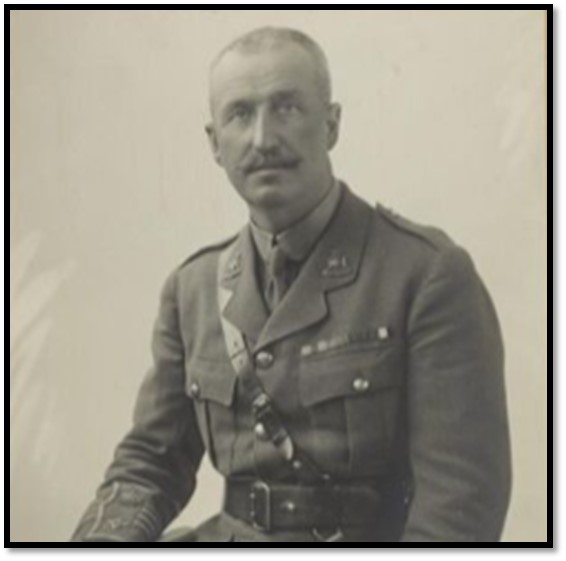
Photo Imperial War Museum: Lt-Col John Carden
In 1912 John Carden retired as the Commandant of Northern Rhodesia Police for which he was awarded the C.M.G. He was serving with the 5th Battalion, Wiltshire Regiment when he was killed in action on 10 August 1915 at Chunuk Bhan Gallipoli.
Travelling on the Zambesi river
Hemans writes that at the time only Government officials on business, Missionaries stationed in Northern Rhodesia and hippo hunters had ever found their way here. “Each turn and bend reveals some new charm, some fresh aspect. At times one drifts with the current down a broad smooth expanse of water, a vivid blue reflected from the cloudless sky above. At others we go more swiftly between towering cliffs clothed from top to bottom with vegetation, with graceful nodding palms on the banks between hill and river…As the sun mounts and the air grows hotter and hotter out come the crocs to bask in the sand-spits, hippo climb onto rocks in mid-stream for their noonday siesta, while troops of baboons and little black-faced monkeys sit turning over loose stones in search of grubs and insects or play their antics to an amused and interested audience. So soon as the boat is sighted crocs slip off into the river, hippos dive in with many a loud splash, while baboons and monkeys make off helter-skelter into the protection of trees and bush…”[29]
The return trip upstream and a description of the BaTonga
Hemans now wanted to study the BaTonga and decided to walk upstream over a 100 miles (160 kms) as far as Binga and then to Chief Nenyunka on the Sengwa river. The journey took two weeks as he stopped to talk with the Chiefs and did some hunting for meat for the carriers. At Chief Sinemsanga’s kraal he shot an elephant but lost one of his dogs to a crocodile.
At the time he says the BaTonga were relatively untouched by civilisation, except for those men who had worked on the mines and farms. The women never left the river. They are related to the BaTonga and Ila who live on the north bank of the Zambesi. Both sexes had their four front teeth knocked out at childhood.[30] Many, especially the women, are heavily tattooed on front and back that are made by small cuts into which wood ash is rubbed and they wear their hair in a variety of patterns.
Men wear a loin cloth from buck or goat hide drawn up tightly between the legs and knotted around the waist. The women wear skin aprons in front and long buck or goat skins behind and tied in front. Unmarried girls also wear a short kilt made from baobab fibre. Many women and older men wear necklaces of fairly large blue beads and well-to-do women wear coils of brass wire round their necks, on their arms from wrist to elbow and on legs from ankle to calf. All cover themselves with the oil from the castor-oil bean and women and children wear red ochre, possibly to deter biting flies.
The women are expert basket-weavers from palm leaves and grasses and they range from the size of a large cup to baskets that can carry 40-50 lbs of grain. The are good potters and pots of all sizes are common in the kraals, but they have no knowledge of the potter’s wheel.
The BaTonga men are skilful workers in iron and the making of ropes from the baobab tree. They fashion iron hoes, knives, barbed spearheads and blades. They are excellent woodworkers with an extensive knowledge of which indigenous trees are suitable for spoons, bowls and dishes. They use dugout canoes on the river for fishing and to keep in contact with relatives on the northern bank of the Zambesi. Some hold just two paddlers, others can carry six to ten passengers. They will cut down a suitable tree and leave it to season before being man-handled down to a sand-spit where fires are lit under the portion to be hollowed out. Small adzes roughly chop out the charred wood before the log is turned over and made into its final shape. Hemans says without a keel they roll easily and require expert paddlers to keep them from upsetting.
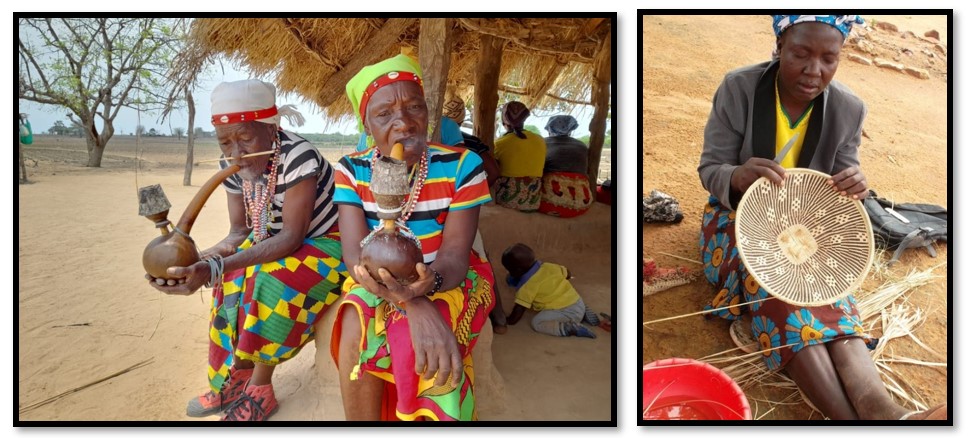
Photo M. Matibiri: BaTonga women, famous for their BaTonga woman basket- weaving inchelwa (smoking pipe)
Every kraal has gardens near the river where they plant millet, pumpkins and melons with the rains to reap in early winter. In May after the floods subside they plant tobacco and maize in the mud carried down; each family patch is neatly fenced with reeds. These crops need to be watered by hand through the winter months and guarded at night by watchmen against wandering hippo.
The patrol leaves the river at Binga
Hemans and his carriers now turned south and soon were climbing the 1,000 feet (305 metres) up the escarpment from the floor of the Zambesi Valley. The steep climb required much energy and everyone was glad to sit and relax once they reached the escarpment’s lip.
Then day after day they marched south, generally aiming to do 14 miles (23 kms) but sometimes more or less depending on the availability of water. Some of the wells required a bucket to be handed up from hand to hand; a lengthy process with 60 – 70 men requiring water!
Sibaba’s kraal
The kraal was like a little oasis in this parched country and very isolated but there was good water and goats and grain to be purchased for the messengers and carriers. The patrol’s grain stocks needed to be guarded at night by the sergeant to prevent pilfering and to ensure they had enough for the entire journey.
The Sijalila Mountains proved a challenge; the shale surface on the slopes proving slippery. “Standing as I did, looking out over the mountains, I had the impression of being on the crest of a huge rocky wave. As far as the eye could reach was a jumbled confusion of broken crests and troughs, seemingly thrown up in the long, dim past in some titanic upheaval of nature. It was as though some huge floods of water in opposing currents flowing with terrific force had been petrified into instant immobility. Great was my relief to find we at last emerged from the mountains…”[31]
They continued into the valley of the Sebungwe river to the first Native Commissioner’s camp at Kariyangwe, now abandoned due to the unhealthy situation when tsetse-fly had spread to the surrounding area making it unsafe for man and animals. Hemans, when Native Commissioner at Wankie, had accompanied the Chief Native Commissioner, Sir Herbert Taylor, here in 1900 on a tour of inspection. Then it had a Native Commissioner and two clerks with twenty native messengers and was a really good station. A spring watered a succession of terraces where vegetables, citrus and banana trees grew. Now it was deserted and in ruins. The camp itself was free of the ‘fly’ and they rested the carriers for a few days. Two graves were sadly neglected and overgrown and needed tidying up; that of Vere Campbell, a former Native Commissioner, who died of blackwater fever and a Dutchman named Rautenbach[32] who was killed by a rhino.
Lonely graves at Kariyangwe of Vere Campbell and Rautenbach
Hemans two dogs were carried through the ‘fly’ in crates covered in mosquito-gauze to ensure their safety. The ‘fly’ ceased once the Sengwa river was crossed and they reached the rest camp of Chief Nenyunka where tax was collected.
Inyoka tobacco
There was a flourishing centre of tobacco growing around the Chief’s kraal. The tobacco leaf is pounded in wooden mortars and then mixed with the ashes of wild aloe and water and pounded again. The mixture is then kneaded into cones weighing from 1lb to 5lbs (2.3kg) and placed on a platform to dry out. These found a ready market at mines and stores and natives travelling through Gokwe would take the cones and sell them for one shilling a lb. Buyers break the cones into pieces and allow the tobacco to dry out before being smoked in pipes or ground into snuff.
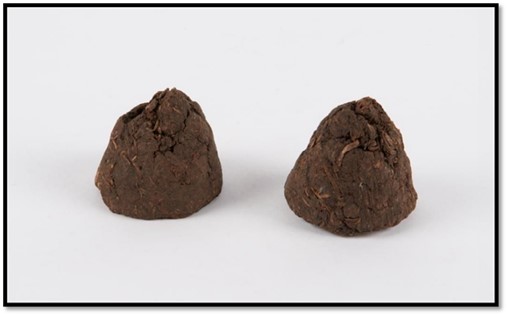
Science Museum Collection: native cone-shaped tobacco cakes
Travelling cross-country to Chief Sileya
The path took them past Biganinyemba, another former Native Department station, now deserted and through miles of gusu forest, also known as ‘Zambezi teak woodland’ or ‘Baikiea forests.’ What glorious mornings they were, “The air crystal clear, with only the tang of the newly lit fire, each breath like a draught of champagne, making one glad to be alive. The rays of the early sun turned the dewdrops on every leaf, each blade of grass, into millions of diamonds which dazzled the eyes with the beauty of their prismatic colours. Surely nothing made by man can compare with what nature can offer in her more gracious moods.”[33]
On the path he shot an exceptionally fine kudu bull with the end spirals turned outside and not the usual inwards. His carriers assured him this was a ‘mountain’ kudu and different from the usual ‘plains’ kudu.
Hemans writes that Chief Sileya was the paramount Chief of the Bashankwe, who formed by far the largest numbers of natives and was always consulted before any new Chief was appointed in his country. He was an intelligent man always carrying out Government instructions ably and willingly. He was sold beautifully prepared skins including civet, genet and gola (blue cat) as well as monkey skins for 6 pence each and a leopard skin for 10 shillings, the skins being sewed together into a kaross.
They now reached the station at Old Gokwe having been away for three months and travelled over 700 miles (1130 kms)
Christmas Day at Old Gokwe
The officials had organised Christmas festivities for the camp and neighbouring Chiefs with sports and prizes for winners and runners-up in each event, also a plentiful beer supply and a fireworks display in the evening, all of which was paid for out of their own pockets.
The activities began after breakfast on Christmas morning and plenty of spectators were present. There were running races, pillow-fights and sack races. Chief Nemangwe, sixty years old, came second in the 200 yards race; his prize a pink silk handkerchief which he wore around his neck with great pride. Lunch consisted of meat and beer and after dinner a gramophone concert followed by a fireworks display – it was considered a great success.
The 1915 drought
Reports began to come in that the lack of rain was resulting in the crops failing. Plans were laid to bring in relief grain over poor tracks by wagon, the heaviest load being 4,000 lbs (1,814 kgs) or 20 bags. On 15 April Hemans set out to inspect the crops over ten days covering about 150 miles (240 kms) Mostly he found the crops were not as poor as he had anticipated but some relief was needed. On 5 July the first mule wagons arrived with 48 maize bags; but the most that could be sent was 500 bags.
Those seeking drought relief had to pay 30 shillings per 200 lb bag, even though transport alone was 15 shillings. Many did not have the cash but were granted grain on credit and Hemans says they paid off every penny in due course.
Life on patrol
Hemans says that in his youth he thought it ‘manly’ to endure hunger, thirst, discomforts and hardships but as he became older and wiser this changed as he came to believe that to keep fit it was essential to eat well. Accordingly he carried, “many varied dainties in tins and bottles, besides desiccated vegetables and dried fruits. As there were only two meals a day whilst on the march, food had to be tasty and tempting, particularly dinner, the great meal of the day.”[34]
“Breakfast at 11am or thereabouts was the rule. Mealie-meal porridge with fresh milk when obtainable, otherwise from the invaluable tin, followed by a buck steak or chops, or grilled breast of guinea-fowl with bacon and fried potatoes, then toast and marmalade, all washed down with one or two cups of coffee.”
“Dinner was a different propositions. At times we arrived at our night camp hot and thirsty…It was then that the sundowner of whisky and sparklet fairly sizzled down one’s throat, that the slice of hot anchovy toast caused the saliva to flow…Towel, my cook, was a marvel on the veld. With a limited batterie-de-cuisine consisting of three saucepans, fry-pan and bake pot, he would serve up a dinner fit for a king. His bread, his omelette, savoury and sweet, were a dream and melted in the mouth. What he intended to be hot was hot, not tepid and greasy, his cold sweets, such as jellies, fruit salad or blancmange, were cold. How he managed it all remained a mystery to me, cooking as he did in the open with his very limited appliances on the hot embers raked from his fire.”
My table-boy was as good in his way as was the cook in his. The folding table always sported a snow-white cloth, my dinner napkin was spotless, the cutlery and silver shone in the light of the acetylene lamp, while wherever possible there was a jar of flowers picked while the day was still light enough to find them.
He and my tent boy set up the camp furniture, made the bed, laid down a reed mat for my feet, prepared the bath, set out my shaving tackle and attended to my personal comforts. I carried an alarm watch set to go off half an hour before dawn. By the time day broke, I was enjoying a steaming cup of hot cocoa or coffee together with a biscuit or rusk while I sat before the fire which had been made up afresh. Before starting, the cook made tea which was poured boiling hot into the thermos carried by the table-boy while we were on the march.”
Another patrol from Kariba Gorge to Siabuwa
Heman mostly describes the hunting on the Old Gokwe section of this patrol to Kariba Gorge. He had not been to Chief Siabuwa’s kraal, very much in the interior of the Sebungwe and says this district was practically unknown. He writes that at one place he shot a hippo bull and G.B. Bull, his companion, shot an eland on the river bank. “Both of these were duly skinned and cut up, the surroundings of our camp resembling a Smithfield market in miniature. Hard as it may be to believe, in two days the meat was gone and the carriers declared themselves hungry again.”
They crossed the Sengwa river and halted at Siyatshepule before a long march through very difficult country with ridge after ridge before dropping down into a valley and the rest camp near Siabuwa’s kraal. Once the tax collection was completed, Hemans was told there were buffalo near the Mtshena river and left early with just his gunbearers and a few carriers as there was no water on the route. After a strenuous walk the rest of the day was spent relaxing. Next day after some searching they came across a grazing herd of buffalo, but it was difficult to see them in the long grass. He picked the biggest shape and fired at what looked like the shoulder. The herd stampeded away at a mad gallop and the gunbearers began to follow the fresh blood through very thick bush, Hemans concentrating on every bush.
“And well it was I did so. While the spoor went straight ahead towards the hills, suddenly from our left front and not more than 15 yards away, charged a big buffalo cow which had, with the cunning of her kind, gone off the trail waiting for us to follow on it and catch us an unawares. Nkana, who was in the lead quickly stepped to one side, leading me to face the music, which was only right and what I had taught him. It was only a matter of a second to get my sight onto her as she charged and a lucky shot took her just above the left eye as she came at me, bringing her down stone-dead with a shot through the brain. She was an enormous animal and it was no wonder I had mistaken her for a bull…”[35]
Then back through the ‘fly’ to the rest camp at Siabuwa. A young policeman, Butler had died of dysentery here the previous year. Hemans took photographs of the grave to send to his mother before leaving for Old Gokwe. “Another lonely white man's grave, of which there are so many in the wildernesses of the world.”
After a few days marching they were within 50 miles of Old Gokwe. That afternoon, “We had barely camped when a strong wind from the northwest suddenly sprang up. All at once I heard the roar of fire from behind us and in no time clouds of smoke and wisps of burnt grass were upon us, preceded by hawks and other birds in search of prey fleeing before the advancing flames…Almost at once we were hemmed in on all sides by a roaring sea of fire, the flames leaping high in the air, while the din of bursting trees and crackling grass combined to stun our ears, making speech impossible except by hard shouting. We came off without any material damage as I had previously backfired all the grass around and about and had the carriers out with green branches to beat out the flames… From August onwards, until the rain start, these fires are a common occurrence and the damage they do is incalculable, as they sweep everything before them.”
Mwengezi Pan and a rhino
During the winter months Hemans made several patrols and a detour to Mwengezi Pan, which was very rarely visited. The carriers were left at Mola and he took only his gunbearers, Nkani and Johnny, a few carriers and Sergeant Mvundhlana and camped a little distance from the pan to cause least disturbance.
He had shot a sable and they were making their way back to camp, “when from the only shady tree in sight trotted out a big rhino cow looking decidedly nasty and coming straight at us. I quickly changed my light rifle for the Express so that I could have a heavier weapon in case of need. Closer and closer she came with snorts of temper until I decided it was time to stop her as I had no intention of making way for her.” The first shot, “brought the cow to her knees, but she was up again like a flesh and at me again so quickly that I had not time to eject the empty shell, which left me with but one barrel loaded with a hard-nose cartridge. She came for me at full gallop, evidently on business bent, to where I stood, rifle to shoulder ready for eventualities. When she was within ten yards or so I took very careful aim past the front horn and fired at the head, and as luck would have it brought her down. She simply collapsed and lay there kneeling. I reloaded as quickly as possible, but there was no need for another shot.”[36]
Herbert Hemans with the rhino he shot at Mwengezi Pan
An inspection visit to Old Gokwe
Few visitors came to Old Gokwe at the end of a dusty hundred mile motor road. “Imagine my pleasure when I heard that the Superintendent of Natives, accompanied by an audit inspector, was to arrive soon to check the office books… Our visitors arrived up to time in a buckboard drawn by six mules, everybody and everything covered in dust from head to foot after the long, dry journey.” Accompanying Major Jackson, the Chief Native Commissioner, was the Auditor-General, Major Everett, who had been Paymaster and Chief Staff Officer in the BSA Police, soon after the relief of Mafeking in 1900 when Hemans had been Sergeant-Major. He writes, “It was with genuine regret that I speeded my friends on their return journey.”
New Gokwe Native Commissioner’s station
In 1923 Hemans was posted back to Gokwe, but not the Old Gokwe he had known, as New Gokwe was 15 miles (24 kms) to the east to avoid tsetse-fly and he had only been there two months when in the midst of a thunderstorm he was woken to hear that the office had caught fire after a lightning strike. Ross Tapson, one of the clerks, was already there with those messengers still in camp. The thatch was on fire, the building was doomed, so they concentrated on rescuing the office safe and as many books and records as they could salvage and eventually the roof collapsed with a crash.
His last patrol
On this last patrol he went without a companion marching down the Sengwa river and then to Binga and down the Zambesi by boat to Kariba Gorge. Returning he travelled up the Ume river-bed intending to hunt buffalo at Msana’s kraal some 40 miles (64 kms) upstream. He was met by a very doleful and despondent deputation who said their crops and grain-bins were being destroyed by a rogue elephant. They could not drive it away with firebrands as it charged on sight. Would the inkosi take pity and shoot the elephant or they would starve.
Hemans decided the needs of the people came first and asked for a reliable tracker and discussed tactics with his gunbearers, Nkani and Johnny. Early next morning Gwangwaba started tracking the elephant from the lands across the river into the bush and back to the river with the spoor getting fresher all the time. At last Gwangwaba stopped, pointed ahead and vanished. The elephant was lying down with its head on an anthill fast asleep. As it was only 20 yards (18 metres) away Hemans decided not to circle around and fired both barrels of his .450 Express.
The elephant stood up, trumpeted loudly and charged straight at him. Without time to reload he remembered thinking, “Well, here’s goodbye” and stood dead still until the beast was almost upon him before springing to his left where he lay blinded by dust and gravel while the elephant charged straight on. After a short rest they took up the trail again. They could see the elephant had slowed up and was losing a lot of blood, until finally they came upon him facing towards them and a couple of shots brought him down. A very old bull, his carriers and the villagers were soon cutting up the carcass for meat.
The date was 29 August 1923, a month before Herbert Hemans fiftieth birthday and he vowed that now he was done with big-game shooting and in fact, never shot any game from then onwards.
1924 Zambesi patrol
Hemans stayed at Gokwe and did the administration and gave Stead and Tapson the responsibility of the long patrol which they thoroughly enjoyed.
Tapson and Stead leave Gokwe on the Zambesi patrol
Sadly towards Christmas his gunbearer Nkani became ill at his kraal with pneumonia and soon after died. They had travelled many miles together after game sharing hardships and facing dangers together. Totally reliable, a companion Hemans had relied upon and who had never let him down.
In March 1925 he noticed that the slightest exertion made his heart pump so hard that he thought it would burst through his chest and walked to Que Que where the doctor diagnosed acute pyorrhoea and was told to have all his teeth out and then take two months leave. This was the end of his stay in the Sebungwe district.

The author used a Kodak No 1 Junior Model A camera: excellent for close photos, but useless for long range
Herbert Nassau Hemans
Born 29 Sep 1871, London England
Died 22 May 1935, Bulawayo, Zimbabwe
Married 27 Jul 1901 Elizabeth Ermina Dottridge
Married 17 May 1924 Mabel Florence Lansdown (8 Sept 1900 – 1985 Bulawayo, Zimbabwe)
Children Audrey Joy Hemans, Trevor John Hemans
In 1898 Hemans joined the B.S.A. Police and then served in the Anglo-Boer War holding the rank of Staff Sergeant-Major and was present at the relief of Mafeking and then put in charge of a refugee camp at Norvalspont on the Orange river.
In May 1907 he joined the Native Department of the Southern Rhodesia Civil Service and was appointed assistant Native Commissioner at Wankie (Hwange) during 1907-1910. He then spent six years in the Sebungwe District, the subject of this article, as Native Commissioner and in 1917 when he returned from long leave he was posted to Gwanda, Inyati, Nyamandhlovu and Umzingwane and in 1920-22 at Wankie[37] before returning to the Sebungwe from 1923-25, from there he moved to Chibi and in 1928 to the Makoni District where he stayed until his retirement in 1933.
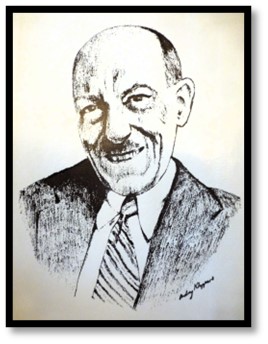
Herbert Nassau Hemans
References
H.N. Hemans. The Log of a Native Commissioner. Books of Rhodesia, Gold Series Vol 15, Bulawayo, 1971
R.C. Smith. Rhodesia, A Postal History – its Stamps, Posts and Telegraphs. R.C. Smith, Salisbury, 1967
https://www.rhodesia.me.uk/wankie. Wankie, Coal Town
[1] Mopane bees or flies or sweat flies Plebeina hildebrandti. They cluster in their hundreds looking for moisture around the mouths and eyes of animals and humans seeking any moisture they can get. Thankfully, they disappear at night
[2] Probably a Model T Ford
[3] H.M.G. Jackson was Native Commissioner at Essexvale in 1896 and is often referred to by F.C. Selous in his book Sunshine and Storm in Rhodesia
[4] The Log of a Native Commissioner, P19
[5] Ibid P181-2
[6][6] R.C. Smith. Rhodesia, A Postal History, P443
[7] The Log of a Native Commissioner, P27
[8] Hemans writes he invariably used the pistol to finish off wounded buck
[9] The Log of a Native Commissioner, P33
[10] Ibid, P35
[11] The Log of a Native Commissioner, P40-41
[12] Ibid, P47
[13] Ibid, P53
[14] The hut tax notes and photos from the website www.worldofcoins.eu/forum/index.php?topic=1837.15 and provided by Malcolm Easton
[15] Heman does not mention the Hot Springs at Lubimbi or any incidents on the march north from Lubimbi to Kaviri
[16] The Native Commissioner’s rest camp is still marked on the 1:250,000 map at Kaviri published in 1973
[17] The Log of a Native Commissioner, P63
[18] The Log of a Native Commissioner, P67
[19] The 1973 Sheet SE-35-7 for Binga marks this as Chibwatata Hot Spring
[20] Leonard Ncube. Binga Hot Springs dry out. Chronicle, 23 July 2022
[21] The Log of a Native Commissioner, P71
[22] Both Sinekoma and Siyampa do not appear on the 1973 map; perhaps these villages had been abandoned
[23] The Log of a Native Commissioner, P75
[24] The sheet SE-35-7 1973 Binga map calls it the Ruziruhuru river
[25] The Log of a Native Commissioner, P89
[26] Recipe for a ‘Zambesi cocktail:’ A dash of bitters, tot of dry gin, lemon to taste and fill up with soda water!
[27] The Log of a Native Commissioner, P97
[28] The Log of a Native Commissioner, P107
[29] The Log of a Native Commissioner, P110-111
[30] One theory is that this made them less desirable as slaves in earlier times
[31] The Log of a Native Commissioner, P125
[32] Rautenbach was a native labour agent recruiting for the mines. He was entertained as a guest for several days before going hunting with a .303 but disregarded all warnings not to hunt rhino. He wounded a rhino with a soft-nosed bullet and it charged and inflicted terrible injuries. He was carried back to the station on a blanket but died after several days.
[33] The Log of a Native Commissioner, P131
[34] The Log of a Native Commissioner, P162
[35] The Log of a Native Commissioner, P171
[36] The Log of a Native Commissioner, P179
[37] Hemans writes that Albert Giese was a good friend and had two farms on the Deka river close to the Botswana border that eventually became part of Hwange National Park. members of the Abananzwa tribe who lived in the Hwange area told the whites after the 1893 invasion of Matabeleland that there were black stones which burned in their district. Albert Giese (c.1864 - 1938) decided to explore the area and in 1895 he pegged coal claims on the Kamandama River, four miles west of what became No. 1 Colliery where an outcrop of coal 30 feet thick is exposed in the river bed. This discovery of coal led to the proposed rail route across the Kariba Gorge, that Hemans had escorted as a BSAP trooper being abandoned, and the trans-continental railway route changed to go via Wankie and then cross the Zambesi river at Victoria Falls, the railhead reaching Wankie in 1903. Sourced from https://www.rhodesia.me.uk/wankie/
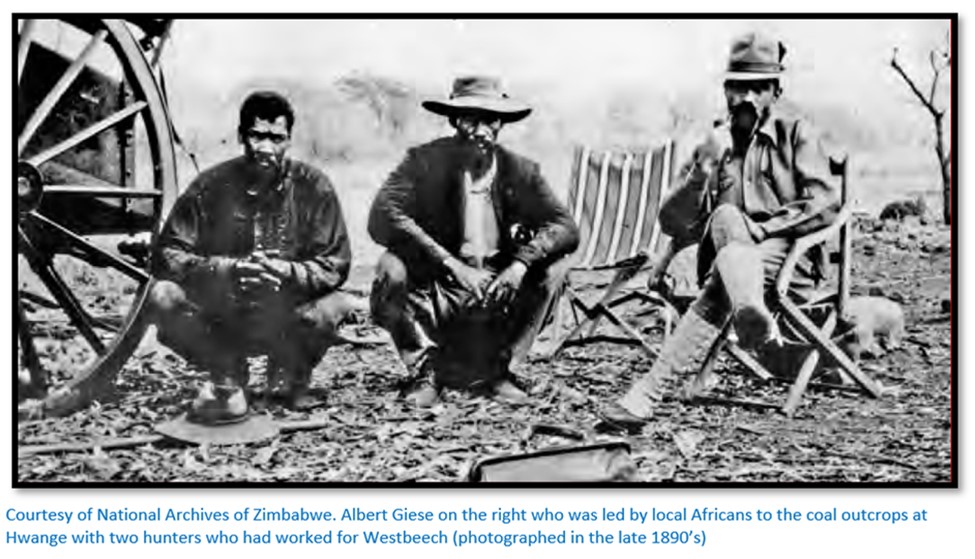
When to visit:
n/a
Fee:
n/a
Category:
Province:

